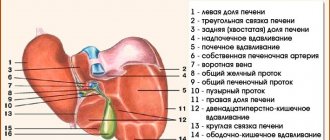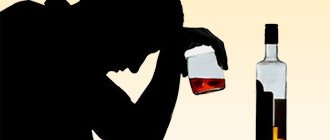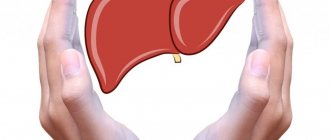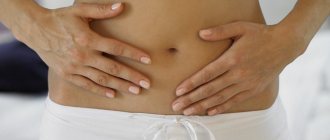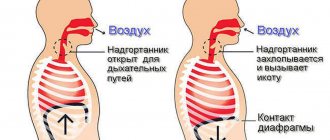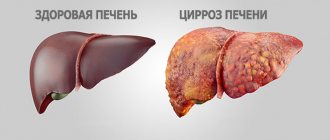Non-alcoholic fatty liver disease (NAFLD) is a pathological change in liver tissue due to excess deposition of fat droplets in hepatocytes (liver cells). This condition is also called steatosis, or fatty degeneration. With this disease, it is important to start treatment on time, otherwise an inflammatory process may begin. In this case, they speak of the development of steatohepatitis, which can subsequently progress to fibrosis and then to cirrhosis of the liver1.
NAFLD is becoming more common. According to studies DIREG1 and DIREG2 (more than 50 thousand participants), the number of outpatients with this disease in Russia over seven years increased from 27 to 37.3%7.
What caused such a sharp increase in the incidence of steatosis?
How common is non-alcoholic fatty liver disease? Forms of the disease
The content of the article
Non-alcoholic fatty liver disease, known as NAFLD, is the most common disease of this organ. However, knowledge about it, even among doctors, is still insufficient.
Non-alcoholic fatty liver disease
NAFLD is estimated to be very common. For example, among overweight and obese people, the percentage of patients with such pathology reaches 50%. These values are similar to or higher than the number of people with hypertension or type 2 diabetes.
Meanwhile, in 5% of patients the disease takes an advanced form called NASH, non-alcoholic steatohepatitis, and in 0.5% it progresses to fatal cirrhosis of the liver. The latter percentages seem small, but in terms of the total number of cases they are huge.
Therefore, NAFLD includes: “simple” steatosis and the more dangerous non-alcoholic steatohepatitis. When the latter form appears, a very serious complication may occur—liver cirrhosis.
Manifestations of the disease
Often, fatty liver disease is asymptomatic3 and is detected in the later stages. However, even at the stage of steatosis and steatohepatitis, nonspecific symptoms may be observed, for example, patients may complain of:
- weakness, fatigue, sleep disturbances,
- discomfort and heaviness in the right hypochondrium,
- dyspepsia: nausea, bloating, stool disorders4.
After collecting complaints and medical history during a physical examination, the doctor can use palpation to diagnose an enlarged liver. To carry out differential diagnosis and verify the diagnosis, the doctor may prescribe additional studies.
Why is the disease called insidious? No signs or symptoms
The disease does not show any symptoms for a very long time (and sometimes not at all). And those that the patient himself experiences, and that the doctor could detect during the examination of the patient (signs).
In simple steatosis, if symptoms occur, they are very nonspecific, meaning they can also occur in a number of other diseases besides NAFLD. Experts typically report two of these symptoms:
- fatigue;
- weak, usually dull pain in the upper right corner of the abdomen.
The condition is similar to other "progressive" diseases: hypertension and type 2 diabetes. But unlike non-alcoholic fatty liver disease, these diseases usually do not develop complications before they can be diagnosed.
In the case of NASH, i.e. a more dangerous form of NAFLD that causes liver degeneration and fibrosis), symptoms may be more typical. More often than with simple steatosis, the following appear:
- dull or aching pain in the right upper abdomen;
- a more intense feeling of tiredness, sometimes it can be severe fatigue;
- unexplained weight loss;
- weakness.
A complication of NASH, liver cirrhosis, is also accompanied by a number of symptoms:
- jaundice, i.e. yellowing of the skin and whites of the eyes;
- skin itching;
- swelling of the entire leg or limited swelling around the ankles or feet;
- nausea, loss of appetite and/or weight loss;
- enlarged abdomen due to fluid accumulation (ascites);
- confusion.
Ascites
But let us repeat once again - these symptoms appear late and relate not to the most common “simple” fatty steatosis, but to a more dangerous form - NASH and cirrhosis of the liver.
News
NAFLD is a spectrum of characteristic liver changes in patients who do not drink alcohol in quantities that cause liver damage. As a rule, this disease is caused by regular consumption of alcohol in small doses, obesity, medication, heredity or infectious factors (viral hepatitis B and C, Wilson-Konovalov disease and others)
Non-alcoholic fatty liver disease includes two concepts: steatosis and steatohepatitis (NASH).
NAFLD in most cases is characterized by an asymptomatic course, so most often this disease is detected accidentally during laboratory and instrumental examination.
Patients with hepatic steatosis usually do not complain. Many people are diagnosed with non-alcoholic liver hepatosis. Symptoms and treatment are the questions that interest patients most. As already mentioned, the clinical picture of the disease is blurred. Often, obesity of liver tissue is not accompanied by pronounced disorders, which significantly complicates timely diagnosis, because patients simply do not seek help. Symptoms of steatohepatitis are nonspecific (increased fatigue, weakness, aching pain in the right hypochondrium without a clear connection with food) and do not correlate with the degree of its activity. At the stage of liver cirrhosis (LC), symptoms appear that indicate the development of hepatocellular failure and portal hypertension: an increase in the size of the abdomen, edema, moderate jaundice, increased bleeding, etc. It should be noted that a distinctive feature of steatosis, unlike other liver diseases, is the absence of skin itching. During the examination of patients with stasis, excess body weight, symptoms of carbohydrate metabolism disorders and arterial hypertension are often revealed. When examining a patient, an enlarged liver is detected in 50–75% of patients. The size and density of liver tissue reflect the degree of steatosis, the severity of fibrotic changes and ultimately determine the nature of disease progression. At the stage of established liver cirrhosis, an enlarged spleen is detected in 95% of cases as a result of NAFLD. Non-alcoholic fatty liver disease develops in four stages:
- Fatty liver, in which there is an accumulation of a large number of lipid droplets in the liver cells and intercellular space. It is worth saying that in many patients this phenomenon does not lead to serious damage to the liver, but in the presence of negative factors, the disease can move to the next stage of development.
- Non-alcoholic steatohepatitis, in which the accumulation of fat is accompanied by the appearance of an inflammatory process.
- Fibrosis is the result of a long-term inflammatory process. Functional liver cells are gradually replaced by connective tissue elements. Scars form, affecting the functioning of the organ.
- Cirrhosis is the final stage of fibrosis, in which most of the normal liver tissue is replaced by scars. The structure and function of the organ are disrupted, which often leads to liver failure.
- If this pathology is suspected, laboratory tests of blood samples are carried out.
When assessing the parameters of a biochemical blood test for steatohepatitis, changes are noted that indicate liver damage: an increase in the level of serum transaminases - ALT and AST - are recorded in 50–90% of cases; gamma-glutamyl transpeptidase (GGTP) and alkaline phosphatase (ALP) – recorded in 30–60% of subjects; hyperbilirubinemia is detected in 12–17% of patients. As a rule, with steatosis, the activity of ALT and AST does not exceed the upper limit of normal by more than 4–5 times. In most cases, the level of ALT dominates over the level of AST, but when NASH transforms into cirrhosis, the complete opposite is observed: a predominance of AST over ALT, while the AST/ALT ratio is rarely more than 2. The degree of increase in serum aminotransferases does not have a significant relationship with the severity of steatosis and liver fibrosis . An increase in the activity of alkaline phosphatase, GGTP and bilirubin, as a rule, is observed no more than 2 times. Of the instrumental methods, the first one is an ultrasound examination of the liver (ultrasound diagnostics), which allows one to identify diffuse changes in the liver tissue and an increase in its size (although this does not always happen). It is advisable to carry out Dopplerography of the vessels of the abdominal cavity to determine the width of the lumen of the vessels and the speed of blood flow. This allows us to determine the presence of signs of portal hypertension. Liver puncture biopsy, while remaining the “gold standard” for diagnosing NAFLD, is an invasive procedure that is performed in a hospital setting, has a number of contraindications and is associated with a risk of complications, including death. This served as the basis for the development of methods for non-invasive assessment of liver diseases. To accurately diagnose the degree of fibrosis, modern non-invasive (replacing biopsy) examination methods are used: elastometry (elastography) of the liver.
Non-alcoholic fatty liver disease: recommendations for patients.
It is necessary to completely and categorically exclude the consumption of even minimal amounts of alcohol. It is necessary to exclude medications and drugs that cause liver damage. A hypocaloric diet is prescribed with a limitation of animal fats (30–90 g/day) and a decrease in carbohydrates (especially quickly digestible ones) - 150 g/day. Fats should be predominantly polyunsaturated (found in fish, nuts). It is important to consume at least 15 g of dietary fiber per day, vegetables and fruits - at least 400–500 g/day. Basic dietary principles: · Limiting fat to 25–30% of the total energy value of food; · Avoid consumption of simple carbohydrates; · The ratio of polyunsaturated and saturated fatty acids in food is more than 1 (exclusion of butter, animal fat, hard margarine, consumption of foods rich in polyunsaturated fatty acids - vegetable oil, seafood, fish, poultry, olives, nuts, taking into account energy needs); · Reducing the consumption of foods high in cholesterol (no more than 300 mg per day) - eliminating offal (liver, kidneys), caviar, egg yolk, raw smoked sausages, fatty meats and dairy products; · Reduce consumption of red meat, giving preference to fish · Elimination of carbonated sweetened drinks, as well as sweet fruit juices · Elimination of foods prepared as a result of food processing such as frying, deep-frying, etc. Along with the diet, daily aerobic physical activity (swimming, walking, gym) is necessary. For an active lifestyle, it is enough to walk from 8,000 to 15,000 steps per day and spend three hours a week. Gradual weight loss reduces the severity of steatosis. Weight loss must be gradual (no more than 500 g/week). A more accelerated reduction in body weight is unacceptable, since it can provoke the progression of steatohepatitis.
If symptoms of NASH are detected, you should consult a doctor for drug treatment.
Gastroenterologist Artyushevskaya A.Yu.
How is NAFLD diagnosed?
The question arises of how to detect this disease in general, since in most cases it is asymptomatic.
NAFLD is diagnosed mainly based on ultrasound of the abdominal cavity, including the liver. Interestingly, fatty liver disease in most cases is discovered by chance when an ultrasound is performed for other reasons, for example, to detect gallstones or to diagnose abdominal pain.
Fatty liver is very characteristic on ultrasound images. Radiologists say that the liver “glows” on the screen and is hyperechoic (its echo is greater than that of the surrounding tissue).
It is important to understand that fatty liver disease can also occur with other conditions or diseases, such as alcohol abuse, certain medications, or hepatitis C.
Early detection of fatty tissue using ultrasound is very important. Early diagnosis of NAFLD helps prevent exacerbation of the disease - NASH, as well as prevent the development of complications, the most important of which is cirrhosis of the liver. Therefore, gastroenterologists recommend regular ultrasound examinations of the liver (abdominal cavity), even if there are no symptoms. This is especially true for patients from risk groups.
Ultrasound of the liver (abdominal cavity)
A group or risk factor is a statistical concept that limits a group of people with a particular condition or disease where the likelihood of developing a particular disease (in our case NAFLD) is higher than in the general population. Therefore, if the risk of developing non-alcoholic fatty liver disease in the entire population is 20-25%, then in type 2 diabetes mellitus this figure reaches 75%. Therefore, type 2 diabetes is a risk factor for the development of NAFLD.
According to European recommendations, ultrasound examination of the abdominal cavity should be carried out for people with:
- obesity;
- risk factors for metabolic disorders - increased waist circumference, hyperglycemia [increased blood sugar levels], hypertriglyceridemia [increased triglyceride levels in the blood], decreased HDL cholesterol, hypertension;
- persistent increase in alanine aminotransferase (ALT).
Symptoms and stages
NAFLD is often asymptomatic at first. The main stages of the disease are listed below6,7.
- Steatosis. Symptoms are almost completely absent. Steatosis is often discovered by chance when the patient seeks help for other reasons. However, fatigue, changes in appetite, and heaviness or discomfort in the right hypochondrium may occur6,7.
- Steatohepatitis. It can also be almost asymptomatic or accompanied by fatigue, weakness and discomfort or pain in the right side of the abdomen, not associated with meals7.
- Fibrosis. This is a condition in which connective tissue takes the place of hepatocytes.
- Cirrhosis. Serious impairment of liver function, which may result in liver failure. Spider veins may appear, the skin and mucous membranes turn yellow, the skin becomes dry, and itching occurs. There may be other symptoms: ascites (accumulation of fluid in the abdominal cavity), varicose veins of the esophagus and stomach and, as a result, bleeding6,7.
How to treat NAFLD?
There is no miracle cure for this disease. In order for adipose tissue to regress, it is necessary to follow an appropriate low-calorie diet and regularly engage in physical activity at least 5 days a week for 30 minutes a day.
Regular physical activity
It is very important to be constantly monitored by a gastroenterologist so as not to miss complications.
Important Diet Guidelines for Non-Alcoholic Fatty Liver Disease
What to avoid in your diet:
- Eliminate saturated fats and red meat, and full-fat dairy products.
- It is important to avoid trans- and hydrogenated (hardened) fats, sugar, and alcohol.
- Eliminate all processed grain products (that is, do not use white flour or white rice in your diet).
Control of sodium content in the diet is mandatory - do not exceed 1500 mg of table salt per day.
Controlling sodium in your diet
Be careful with supplements and medications, many have contraindications for liver disease. Before taking them, you should definitely consult a gastroenterologist.
Useful products for patients with non-alcoholic liver disease:
- Extra virgin olive oil - for frying and three tablespoons per day orally.
- Fruits and vegetables (but watch the salt content!).
- High fiber foods such as whole grain bread and brown rice.
- Oily fish several times a week.
- Skinless chicken and only lean pork.
- Vegetable protein (legumes) without restrictions.
- Coffee - no more than 3 cups of filtered coffee per day.
